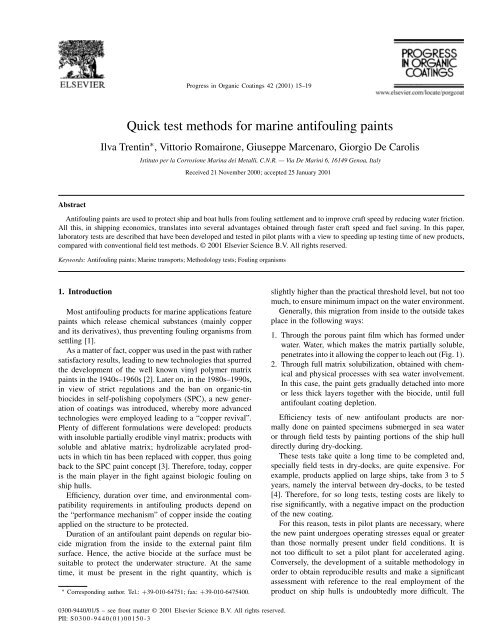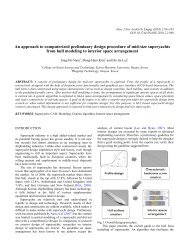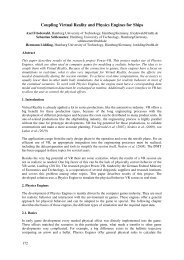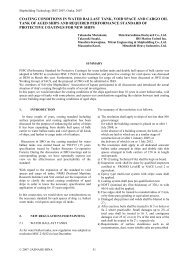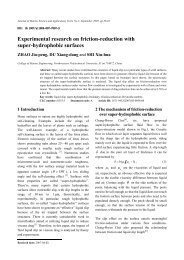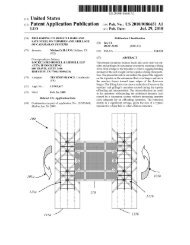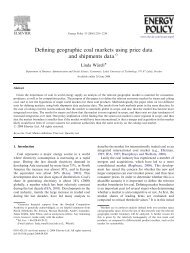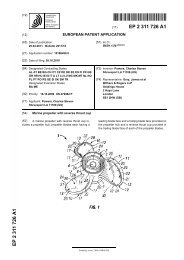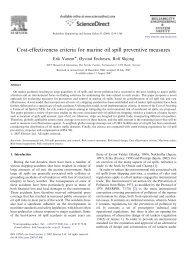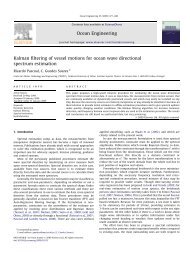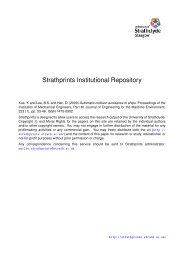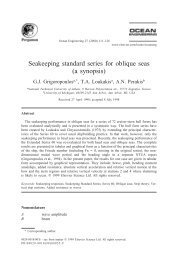Quick test methods for marine antifouling paints
Quick test methods for marine antifouling paints
Quick test methods for marine antifouling paints
You also want an ePaper? Increase the reach of your titles
YUMPU automatically turns print PDFs into web optimized ePapers that Google loves.
Progress in Organic Coatings 42 (2001) 15–19<br />
<strong>Quick</strong> <strong>test</strong> <strong>methods</strong> <strong>for</strong> <strong>marine</strong> <strong>antifouling</strong> <strong>paints</strong><br />
Ilva Trentin ∗ , Vittorio Romairone, Giuseppe Marcenaro, Giorgio De Carolis<br />
Istituto per la Corrosione Marina dei Metalli, C.N.R. — Via De Marini 6, 16149 Genoa, Italy<br />
Received 21 November 2000; accepted 25 January 2001<br />
Abstract<br />
Antifouling <strong>paints</strong> are used to protect ship and boat hulls from fouling settlement and to improve craft speed by reducing water friction.<br />
All this, in shipping economics, translates into several advantages obtained through faster craft speed and fuel saving. In this paper,<br />
laboratory <strong>test</strong>s are described that have been developed and <strong>test</strong>ed in pilot plants with a view to speeding up <strong>test</strong>ing time of new products,<br />
compared with conventional field <strong>test</strong> <strong>methods</strong>. © 2001 Elsevier Science B.V. All rights reserved.<br />
Keywords: Antifouling <strong>paints</strong>; Marine transports; Methodology <strong>test</strong>s; Fouling organisms<br />
1. Introduction<br />
Most <strong>antifouling</strong> products <strong>for</strong> <strong>marine</strong> applications feature<br />
<strong>paints</strong> which release chemical substances (mainly copper<br />
and its derivatives), thus preventing fouling organisms from<br />
settling [1].<br />
As a matter of fact, copper was used in the past with rather<br />
satisfactory results, leading to new technologies that spurred<br />
the development of the well known vinyl polymer matrix<br />
<strong>paints</strong> in the 1940s–1960s [2]. Later on, in the 1980s–1990s,<br />
in view of strict regulations and the ban on organic-tin<br />
biocides in self-polishing copolymers (SPC), a new generation<br />
of coatings was introduced, whereby more advanced<br />
technologies were employed leading to a “copper revival”.<br />
Plenty of different <strong>for</strong>mulations were developed: products<br />
with insoluble partially erodible vinyl matrix; products with<br />
soluble and ablative matrix; hydrolizable acrylated products<br />
in which tin has been replaced with copper, thus going<br />
back to the SPC paint concept [3]. There<strong>for</strong>e, today, copper<br />
is the main player in the fight against biologic fouling on<br />
ship hulls.<br />
Efficiency, duration over time, and environmental compatibility<br />
requirements in <strong>antifouling</strong> products depend on<br />
the “per<strong>for</strong>mance mechanism” of copper inside the coating<br />
applied on the structure to be protected.<br />
Duration of an antifoulant paint depends on regular biocide<br />
migration from the inside to the external paint film<br />
surface. Hence, the active biocide at the surface must be<br />
suitable to protect the underwater structure. At the same<br />
time, it must be present in the right quantity, which is<br />
∗ Corresponding author. Tel.: +39-010-64751; fax: +39-010-6475400.<br />
slightly higher than the practical threshold level, but not too<br />
much, to ensure minimum impact on the water environment.<br />
Generally, this migration from inside to the outside takes<br />
place in the following ways:<br />
1. Through the porous paint film which has <strong>for</strong>med under<br />
water. Water, which makes the matrix partially soluble,<br />
penetrates into it allowing the copper to leach out (Fig. 1).<br />
2. Through full matrix solubilization, obtained with chemical<br />
and physical processes with sea water involvement.<br />
In this case, the paint gets gradually detached into more<br />
or less thick layers together with the biocide, until full<br />
antifoulant coating depletion.<br />
Efficiency <strong>test</strong>s of new antifoulant products are normally<br />
done on painted specimens submerged in sea water<br />
or through field <strong>test</strong>s by painting portions of the ship hull<br />
directly during dry-docking.<br />
These <strong>test</strong>s take quite a long time to be completed and,<br />
specially field <strong>test</strong>s in dry-docks, are quite expensive. For<br />
example, products applied on large ships, take from 3 to 5<br />
years, namely the interval between dry-docks, to be <strong>test</strong>ed<br />
[4]. There<strong>for</strong>e, <strong>for</strong> so long <strong>test</strong>s, <strong>test</strong>ing costs are likely to<br />
rise significantly, with a negative impact on the production<br />
of the new coating.<br />
For this reason, <strong>test</strong>s in pilot plants are necessary, where<br />
the new paint undergoes operating stresses equal or greater<br />
than those normally present under field conditions. It is<br />
not too difficult to set a pilot plant <strong>for</strong> accelerated aging.<br />
Conversely, the development of a suitable methodology in<br />
order to obtain reproducible results and make a significant<br />
assessment with reference to the real employment of the<br />
product on ship hulls is undoubtedly more difficult. The<br />
0300-9440/01/$ – see front matter © 2001 Elsevier Science B.V. All rights reserved.<br />
PII: S0300-9440(01)00150-3
16 I. Trentin et al. / Progress in Organic Coatings 42 (2001) 15–19<br />
Fig. 1. Porosity of insoluble partially erodible matrix coating which is still effective after 3 years of aging at sea (static immersion <strong>test</strong> of painted specimens).<br />
Sea water solubilizes the matrix soluble parts (Rosine) thus creating something which, at 4000× magnification, looks like a huge cavern structure.<br />
goal of our work is indeed to develop these systems and<br />
benchmark laboratory <strong>methods</strong> with conventional field <strong>test</strong>ing,<br />
by using, as a standard, <strong>paints</strong> that have already been<br />
<strong>test</strong>ed in many years of application on ship hulls.<br />
2. Methods<br />
In this study, three types of <strong>paints</strong> have been taken as standard:<br />
the first is a partially erodible insoluble matrix paint<br />
(a); the second is a self-polishing controlled polymer dissolution<br />
paint (ablative paint) (b); the third is a self-polishing<br />
paint with a less soluble matrix (c). Cuprous oxide was the<br />
main biocide contained in all three coatings.<br />
These <strong>paints</strong> have been previously <strong>test</strong>ed with conventional<br />
<strong>methods</strong> as follows:<br />
1. in static immersion of painted specimens;<br />
2. in field <strong>test</strong>s on the hull of a ship.<br />
In the first case, product “a” showed a higher efficiency<br />
than product “b”, since it inhibited fouling settlement <strong>for</strong><br />
over 3 years. Product “b”’ resulted to be effective <strong>for</strong> 2 years.<br />
In the second case, product “b” had a duration nearly 3<br />
years, whereas product “c” was no longer effective after 1.5<br />
years.<br />
Together with field <strong>test</strong>s, accelerated aging <strong>test</strong>s were also<br />
carried out in the laboratory, namely,<br />
1. accelerated aging tank;<br />
2. accelerated aging turbine.<br />
Two different pieces of equipment were employed: the<br />
first was a 150 l tank with circulating water at a rate of<br />
2.5 l/min; a propeller agitator, submerged at the center of the<br />
tank, creating an ascending water current along the four tank<br />
walls, that lapped painted specimens at a speed of 0.2 m/s<br />
(Fig. 2).<br />
In the second apparatus, specimens were arranged at the<br />
center of another smaller tank filled with flowing sea water<br />
and exposed to the flow of water agitated by a 680 rpm<br />
rotary turbine. Specimens were rotating at the same speed<br />
of the turbine but opposite to the water flow direction. The<br />
tangential friction of water on the painted surface created a<br />
highly, yet difficult to measure, dynamic situation (Fig. 3).<br />
In the first <strong>test</strong> <strong>paints</strong> were kept in the aging tank <strong>for</strong><br />
7 months at a temperature which was adjusted to seasonal<br />
variations and ranged from a 25 ◦ C maximum to 18 ◦ C minimum.<br />
In the second <strong>test</strong>, in the more dynamic turbine aging<br />
plant, specimens were <strong>test</strong>ed <strong>for</strong> 35 days at 24 ◦ C operating<br />
temperature.<br />
Natural coastal sea water was employed <strong>for</strong> these <strong>test</strong>s,<br />
which had varying salinity ranging from 36 to 38 ppt,<br />
depending on weather conditions, with a stable pH of<br />
approximately 8.2.<br />
During <strong>test</strong>ing we took the specimens out of their respective<br />
tanks and temporarily (1.5 h) submerged them in<br />
containers with 1.2 l of natural sea water which had been<br />
standardized according to the following parameters: paper<br />
filtered, 37 ppt salinity correction, 25 ◦ C temperature. The<br />
aim was in fact to evaluate the biocide leaching rate and<br />
consequently the accelerated aging level of the paint.<br />
In addition, to confirm the accelerated aging level of the<br />
paint another method was done. For product “a” we checked<br />
by microprobe analysis, the amount of copper present on the
I. Trentin et al. / Progress in Organic Coatings 42 (2001) 15–19 17<br />
Fig. 2. Accelerated aging tank: (a) propeller agitator; (b) descending current; (c) ascending current; (d) painted specimens; (e) water inlet; (f) drain.<br />
Fig. 3. Accelerated aging turbine: (a) turbine rotation; (b) specimens rotation; (c) water flow direction; (d) painted specimens.<br />
paint surface. The lower peak in this element (highlighted<br />
by a small circle) may indicate a faster consumption and<br />
quicker release into the water (Fig. 4).<br />
A similar comparison was done <strong>for</strong> product “b”<br />
(self-polishing) in lab <strong>test</strong> with the aging tank, with the<br />
aging turbine and in the static immersion <strong>test</strong> at sea, but in<br />
the last case no response was possible in that after 3 years<br />
of water exposure the paint was fully depleted.<br />
3. Results<br />
The data reported in the graph of Fig. 5 show the amounts<br />
of copper released by the <strong>paints</strong> per unit of time and surface<br />
during the 7–month <strong>test</strong> period in the tank. Both benchmarked<br />
products “a” and “b” show regular efficiency in the<br />
central part of the graph. However, product “b” stops to<br />
be effective (biocide below threshold) 1 month earlier than<br />
product “a”.<br />
Fig. 4. Microprobe analysis of paint “a”: (1) paint be<strong>for</strong>e <strong>test</strong>s; (2) tank<br />
<strong>test</strong>: 7 months; (3) static immersion: 3 years.
18 I. Trentin et al. / Progress in Organic Coatings 42 (2001) 15–19<br />
Fig. 5. Accelerated aging tank: (paint “a”) insoluble/erodible matrix; (paint<br />
“b”) self-polishing (ablative).<br />
Fig. 7. Accelerated aging turbine: (paint “b”) self-polishing; (paint “c”)<br />
self-polishing (less soluble matrix).<br />
In static immersion <strong>test</strong>s of specimens at sea (conventional<br />
<strong>test</strong>s), when the two <strong>paints</strong> were compared, the same<br />
results were obtained. However, the duration <strong>for</strong> product “a”<br />
(partially erodible insoluble matrix) was over 3 years and<br />
<strong>for</strong> product “b” (soft matrix self-polishing), was 2 years, as<br />
indicated in the graph of Fig. 6.<br />
The lower efficiency duration of product “b” is undoubtedly<br />
due to higher film consumption rate. Indeed, from the<br />
examination carried out both at the beginning and at the<br />
end of the tank <strong>test</strong>s, the consumption rate was found to<br />
be 10 m per month, whereas the partially erodible matrix<br />
product had a consumption rate of only 4 m per month. It<br />
is thus clear that, <strong>for</strong> self-polishing <strong>paints</strong>, the active film<br />
thickness has to be accurately calculated, depending on<br />
desired <strong>antifouling</strong> efficiency duration.<br />
The graph of Fig. 7 reports data referred to benchmarked<br />
<strong>paints</strong> “b” and “c”, which were <strong>test</strong>ed in the high dynamic<br />
turbine lab tank. It can be noted that in just 35 days of <strong>test</strong>,<br />
copper release is more regular and greater than threshold<br />
levels <strong>for</strong> product “b”, whereas <strong>for</strong> product “c” the release<br />
Fig. 8. Ship hull <strong>test</strong>: (paint “b”) self-polishing; (paint “c”) self-polishing<br />
(less soluble matrix).<br />
rate drops more rapidly, and in only 25 days the amount<br />
of copper released is no longer sufficient to inhibit fouling<br />
settlement.<br />
It had taken nearly 3 years to achieve the same outcome<br />
in the field <strong>test</strong>, on a ship hull, <strong>for</strong> product “b” and 1.5 years<br />
<strong>for</strong> product “c” (Fig. 8).<br />
4. Discussion and conclusions<br />
Fig. 6. Static immersion <strong>test</strong>s at sea: (paint “a”) insoluble/erodible matrix;<br />
(paint “b”) self-polishing (ablative).<br />
Laboratory <strong>test</strong>s have indeed shown an accelerated paint<br />
“consumption” compared to conventional field <strong>test</strong>s.<br />
The outcome obtained from laboratory <strong>test</strong>s has been interpreted<br />
by examining the copper released by the paint film<br />
into the water, as well as the amounts of copper still present<br />
on the outermost layer of the antifoulant coating. Hence,<br />
the residual ability to either inhibit or not fouling settlement<br />
was verified on the basis of theoretical threshold values<br />
obtained from the literature [5], as well as from practical<br />
values obtained from field <strong>test</strong>s at sea. These values resulted<br />
to fall within a 10 to 20 g/cm 2 per day range, and refer<br />
to cuprous oxide as biocide and to the specific geographic
I. Trentin et al. / Progress in Organic Coatings 42 (2001) 15–19 19<br />
field <strong>test</strong> area (Mediterranean area with mild temperate<br />
climate).<br />
Results from static immersion <strong>test</strong>s at sea of specimens<br />
painted with the three standard coatings were obtained by<br />
recording the time when fouling was first observed in significant<br />
amounts on exposed surfaces. The real threshold value<br />
mentioned above was obtained by matching them with analytical<br />
data on the amounts of copper released into the water.<br />
This is a fundamental value, because it is the link between<br />
theoretical laboratory and practical field <strong>test</strong>s.<br />
In fact a ship hull covered with fouling organisms means<br />
that <strong>antifouling</strong> paint had exhausted or restricted its <strong>antifouling</strong><br />
activity, because the biocide amount dropped below the<br />
threshold value.<br />
In accelerated aging <strong>test</strong>s, the amounts of biocide released<br />
over time indicate product efficiency, and when they drop<br />
below threshold values, <strong>test</strong>ing is finished.<br />
Actually, by comparing field and laboratory <strong>test</strong> duration,<br />
laboratory <strong>test</strong>s proved to be significantly shorter, with a<br />
reduction in time from several years <strong>for</strong> field <strong>test</strong>s, to just a<br />
few months and days <strong>for</strong> laboratory <strong>test</strong>s.<br />
Furthermore, similar results were obtained from the laboratory<br />
<strong>test</strong> in the tank and the static immersion <strong>test</strong> of<br />
specimens at sea on one side, and between the turbine <strong>test</strong><br />
and the field <strong>test</strong> on the hull on the other side. In the first<br />
two types of <strong>test</strong>s (tank and static immersion), which are<br />
less affected by hydrodynamic conditions, chemical factors<br />
are more likely to have an impact on a faster aging<br />
of product “b” over product “a”. Conversely, in the second<br />
type of <strong>test</strong>s (turbine and vessel), involving a much greater<br />
mechanical action, physical factors prevail, accelerating<br />
the consumption of product “c” (hard matrix) faster than<br />
product “b” (self-polishing coating with soft matrix).<br />
In conclusion, owing to the limited number of <strong>test</strong>s so far<br />
conducted, the need <strong>for</strong> field <strong>test</strong>s on experimental products<br />
cannot be ruled out yet in absolute terms. Our work is just a<br />
contribution which adds to the work of other, not too many<br />
yet, authors [6], who have tried to tackle this very complex<br />
issue. Vessels often operate in geographic areas that are a<br />
severe “<strong>test</strong> bench” owing to the aggressive and resistant<br />
nature of fouling. Also, they often have differing and irregular<br />
operating schedules. Just think of the different types<br />
of operations between a military vessel, a cargo vessel,<br />
an oil tanker, a passenger ferry boat, a cruiser vessel, etc.<br />
Navigation under strong dynamic conditions, long stops in<br />
ports with highly eutrophic water, in region with different<br />
climate conditions, are all elements that play an important<br />
role in maritime transport economics.<br />
There<strong>for</strong>e, antifoulant coatings are designed with an eye<br />
to the chemical and/or physical processes that may take<br />
place under certain environmental conditions. However,<br />
guaranteeing the product efficiency in absolute terms is difficult,<br />
specially when complex physical, chemical, biological<br />
events, human events (e.g. sea water pollution) and restrictive<br />
environment protection regulations, make the activity<br />
of an <strong>antifouling</strong> coating a real challenge, not easy to win.<br />
References<br />
[1] G. Swain, Protect. Coat. Eur. PCE 4 (7) (1999) 18.<br />
[2] G. Torriano, Accademia Navale, Livorno, 4–7 April 1995, p. 21.<br />
[3] J.E. Hunter, Antifouling coatings and the global environmental debate,<br />
Protect. Coat. Eur. PCE 2 (11) (1997) 16.<br />
[4] R. Chapman, Protect. Coat. Eur. PCE 3 (3) (1998) 32.<br />
[5] F.H. de La Court, H.J. de Vries, Prog. Org. Coat. 1 (1973) 375.<br />
[6] J.J. Caprari, O. Slutzky, Pitture e Vernici Eur. 74 (13) (1998) 7.


